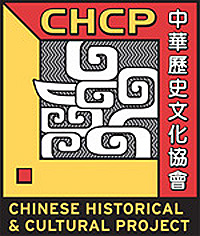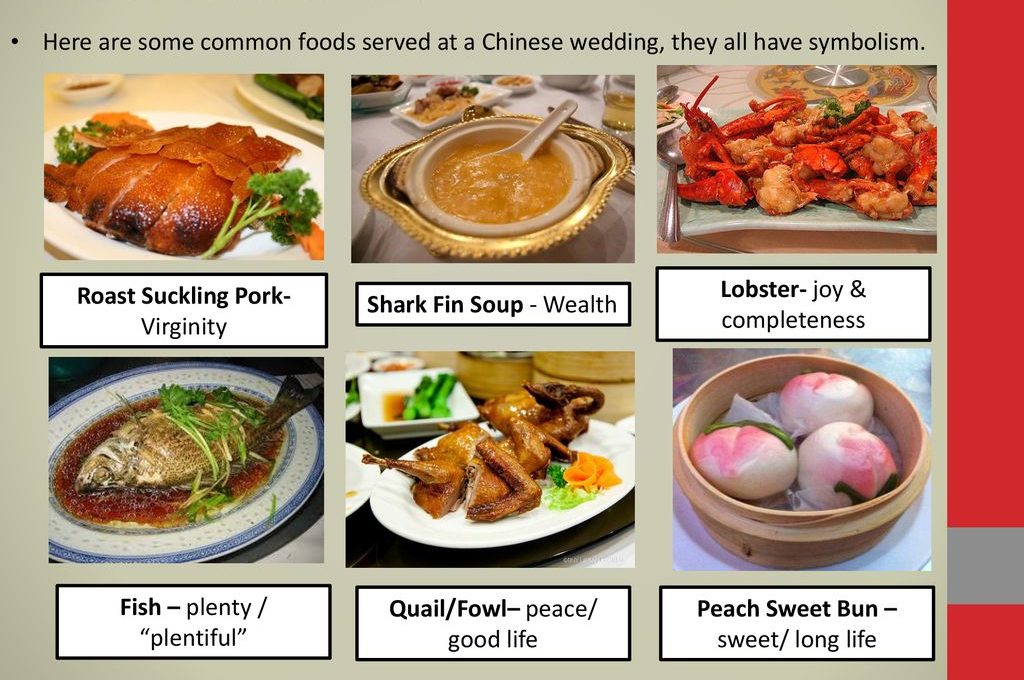|
- Home
- Chinese Wedding Foods
Chinese Wedding Foods
Question:
I’m getting married soon, and hope you’ll be able to answer some questions I have. About one third of the wedding banquet guests are not Chinese. We would like to give an explanation on what the various foods represent and why they are served at banquets. We will be serving: roasted suckling pig, shark’s fin soup, deep fried crab claws, squab, Peking duck, lobster, vegetables with sea cucumber, and fish. For dessert we will be having hot sweet red bean soup and two dumpling-like things that I don’t have names for. The first is a white and pink peach shaped bun with sweet lotus paste in the center. The second is a round sticky dumpling covered with crushed peanuts on the outside and filled with sweet black sesame paste in the center. Do you have any ideas what all these foods represent? Any help would be greatly appreciated.
Answer:
Chinese food has special symbolism: mostly wishes of happiness, longevity, or fertility. The number of courses is also significant. At a Chinese wedding banquet, eight dishes are usually served – not including the dessert. In Chinese, the word “eight” sounds like “good luck.” (The words for “nine” and “long” are also homophones, words that sound the same but have different meanings. At a birthday banquet, nine dishes are served with noodles at the end.)
Nowadays, a wedding banquet starts with appetizers such as “dragon-phoenix” plates or cold plates which consist of various sliced meats, jellyfish, and various types of nuts shaped like dragons and phoenixes and served chilled. (Lobster in Chinese is literally “dragon shrimp” and in Chinese restaurants, chicken feet are referred to as “phoenix feet”). In a marriage, the dragon symbolizes the male role while the phoenix symbolizes the female role. (See Chinese Wedding Traditions for additional use of the Dragon and Phoenix symbolism.) This yin-yang dualism, opposite but not contradictory, is a key concept of taoism according to Professor George Lee of San Francisco State University. He and others believe that taoism and the yin-yang dualism pervades Chinese philosophy. Lee wrote that according to the Black Sect Tantric Buddhism, “man and woman form a family – the tao of marriage.” Therefore, having lobster and chicken at the dinner would represent balance in the new relationship.
Regarding specific menu item selections:
Shark’s Fin Soup: Soup usually follows the appetizers. The type of soup has some significance, for example, shark’s fin soup indicates wealth because this delicacy is very expensive.
Roast Suckling Pig: Roasted pork is a symbol of virginity. (The groom presents a whole roasted pork to the bride’s family at the engagement party.)
Peking Duck and Lobster: Red is the color for happiness, so serving Peking duck and lobster would signify joy and celebration. Also, serving the dish whole, i.e. with the head and legs, would symbolize completeness.
Squab (or Other Fowl): According to Shu Shu Costa, the author of Wild Geese and Tea, pigeon has tender meat that symbolizes peace. Usually two pigeons are offered to wish the newlyweds peace as they start their new life together. Squab (pigeon) is similar to quail, so they both probably symbolize peace. Quail is offered whole to each guest so each and every one will also experience a peaceful life. Serving fried chicken would wish the couple to have a good life because in Chinese “red chicken” sounds like “good life.”
Crab Claws: If you want to serve crab, I suggest you serve the whole crab and not just the claws, which is separated from its other parts. Since you will serve lobster, I recommend that you replace the crab claws with fried chicken because of my explanation above. A typical Chinese banquet usually includes chicken and duck.
Vegetables with Sea Cucumber: Serving sea cucumber with vegetables is a sign of selflessness because “sea cucumber” sounds like “good heart” and this dish wishes the couple to think in a similar way – to avoid conflict.
Fish: Serving fish would hope that the couple will experience a life together with abundance because “fish”” sounds like “plentiful” in Chinese.
Noodles: Usually served at the end, noodles would symbolize longevity because noodles come in long strands.
Sweet Red Bean Soup and Sweet Buns: Serving dessert probably wishes the newlyweds a sweet life. The hot sweet red bean soup should contain lotus seeds (lian zi) and a bark-like vegetable (bak hop) to wish the newlyweds a hundred years of togetherness. The sweet lotus paste in sweetened steamed bread symbolizes fertility; it is shaped and colored to resemble peaches (ta zi), since the peach represents long life. The sticky dumpling you describe, covered with crushed peanuts with black sesame paste in the center, is called mochi. (You might consider mochi with lotus paste or red bean paste for their symbolic value rather than black sesame paste.)
At the end of the banquet, waiters usually pass out take-out boxes to the guests because there is usually enough food for everyone and some left over; this represents abundance. It is acceptable to take some of the food home because it is not good to waste good food – or anything else for that matter.
Tea, alcohol, and 7-Up are almost always supplied at a Chinese wedding banquet. Offering tea is a sign of respect. Alcohol is served to celebrate the special occasion. (In Chinese, “going to a dinner banquet” is synonymous to “going to drink alcohol”; and in Cantonese, “to go drinking” literally means “go to a bar.”) And 7-Up sounds like “seven happiness”, since the words for “up” and “happiness” are homophones.)
You might notice that Chinese restaurants have a big Chinese character behind the head table; it is the character for “double happiness” which is used during wedding events.
By L. K. Yee
Reference:
Shu Shu Costa. Wild Geese and Tea: Asian-American Wedding Planner. NY: Riverhead Books, 1997


